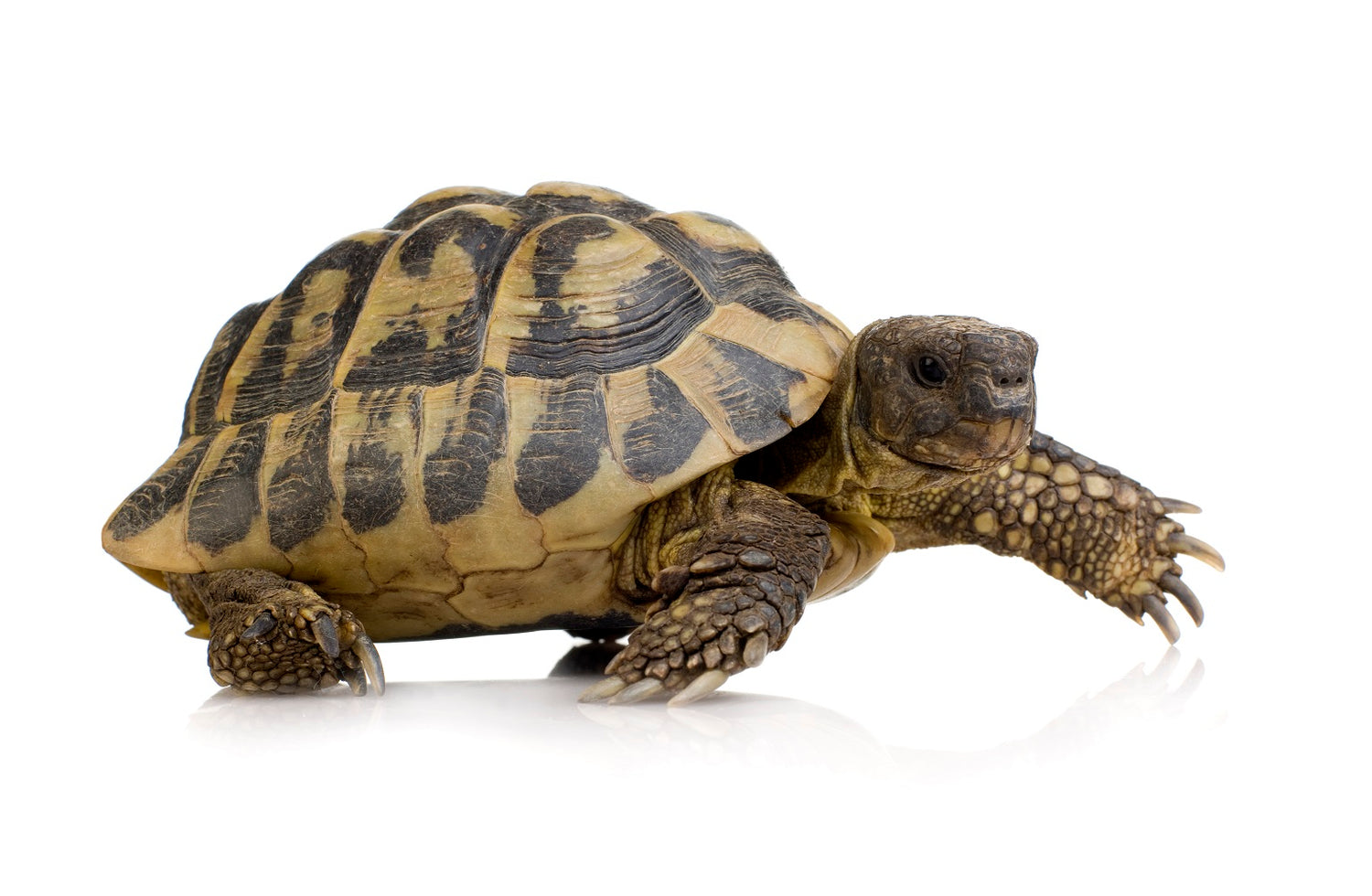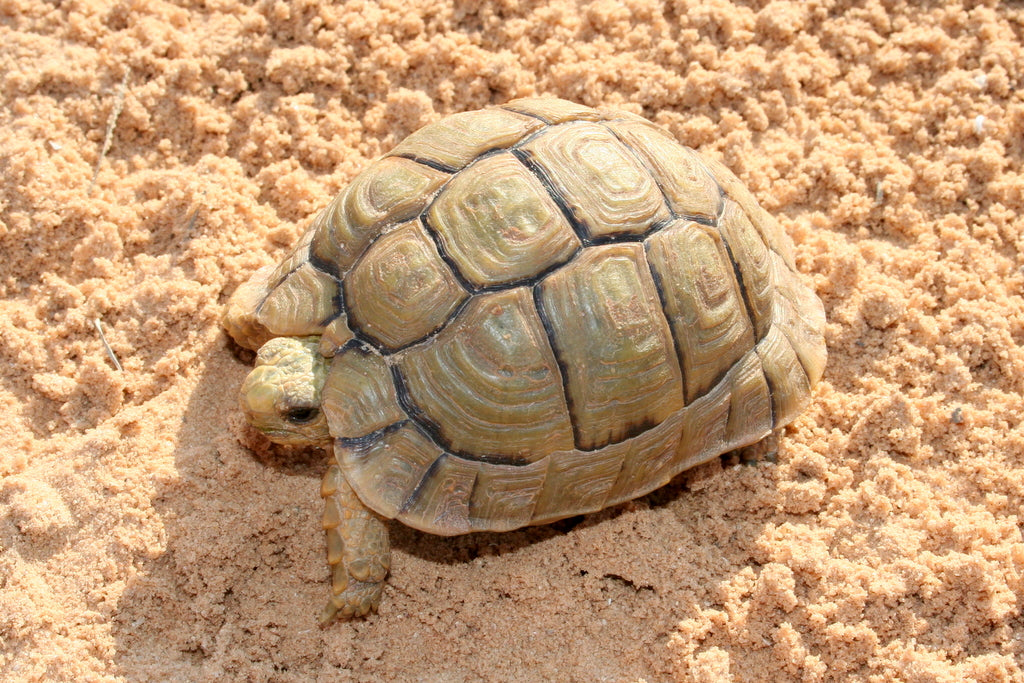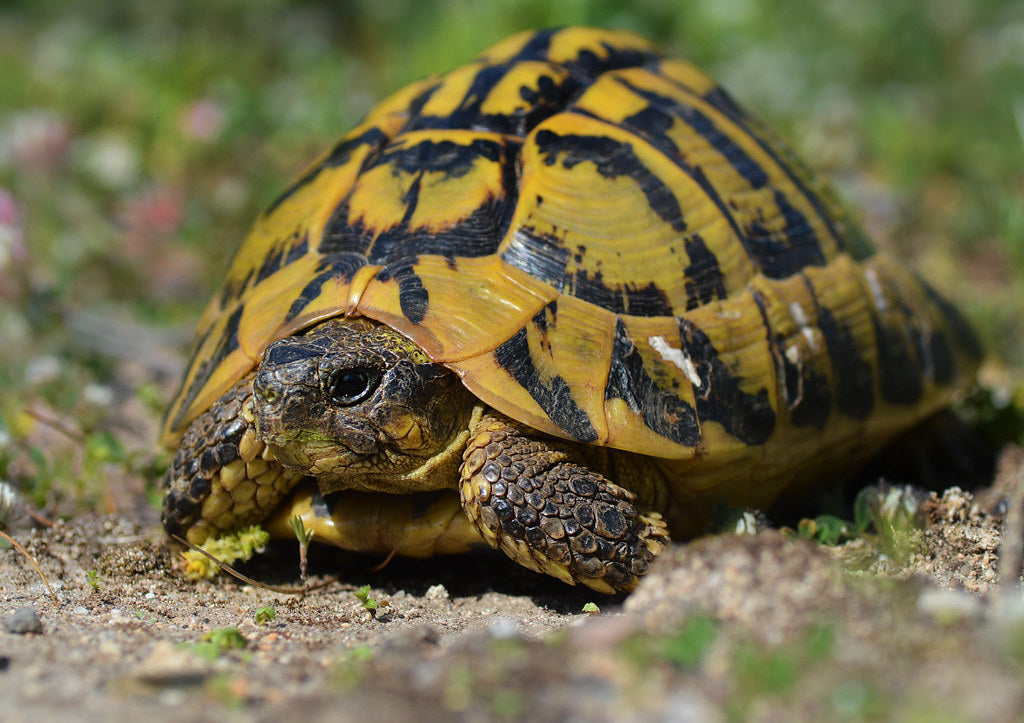Greek tortoises (Testudo graeca) are a group of small to medium-sized tortoises native to the Mediterranean coast and southwest Asia. They can be found in a variety of habitats, including grassland, scrub, and forest.
Greek tortoises can be as small as 5” long to as large as 12”, depending on subspecies. They have a highly domed shell, boxy head, blunt snout, large eyes, and large tubercles on each thigh. Patterning depends on subspecies, but generally Greek tortoises are gold-brown and with black markings.
Greek tortoises are popular pets, and fairly easy to care for, but keeping one as a pet is no casual endeavor — they can easily live into their 50s, and there are reports of Greek tortoises past 100!
How much space do Greek tortoises need?
A single Greek tortoise should have no less than 12 square feet of floor space. Like most tortoises, they are poor climbers and as such floor space is the most important consideration for an enclosure. If you can provide larger, do it!
Because of relatively low humidity requirements, it is possible to house this species in a “tortoise table” setup as long as 1) they are bigger than 3” long, and 2) they have access to areas of higher humidity, such as humid hides and burrows. However, it’s optimal to keep your Greek tortoise in an outdoor pen, if your local climate is suitable. Aside from providing free heat and UVB, outdoor pens make it easy to provide a much larger enclosure for your pet.
However, if you are raising a hatchling, avoid outdoor pens and tortoise tables at first. It’s best to use an enclosed terrarium for hatchlings so they don’t get dehydrated.
Greek tortoises can be successfully housed together, but it doesn’t seem to be required for their wellbeing. If you want to have more than one, use a large enclosure and buy them all at the same time so they can get used to each other.
Do Greek tortoises need UVB?
Yes. Aside from helping provide a day/night cycle and an infinite supply of vitamin D, UVB is also essential to your tortoise’s overall health. The best UVB bulbs for Greek tortoises are:
- Arcadia T5 HO 12%
- Zoo Med T5 HO Reptisun 10.0
The UVB bulb and fixture should be roughly half the total length of the enclosure. When the bulb is mounted in an Arcadia or Vivarium Electronics fixture without mesh obstruction, it should be 17-18” above the tortoise’s shell.
Because a large enclosure is required for Greek tortoises, if you are housing yours indoors, a single UVB bulb and your room’s ambient lighting will likely not be enough to sufficiently illuminate the enclosure. Add a strong 6500K LED or T5 HO fluorescent grow light to energize your tortoise and better simulate daylight
All lighting should be on for 14 hours/day during summer and 10 hours/day during winter.
If your tortoise is being housed outside and has access to direct sunlight, artificial lighting of any kind is not required.
What basking temperatures do Greek tortoises need?
Greek tortoises should have a basking temperature of 95-105°F, with a cool/shaded area on the other side of the enclosure between 75-85°F. Heat should be turned off at night. Temperature should be measured with digital probe thermometers.
Because of their large, domed shells, it’s best to create a basking area for your Greek tortoise with a cluster of at least two halogen heat lamps placed on one side of the enclosure, mounted at least 8” above the tortoise’s shell to provide even heating. Do not use ceramic heat emitters (CHEs), heat mats, red bulbs, or blue bulbs, as these are not as effective.
Supplementary heating is usually not required for outdoor tortoise enclosures. However, if your nighttime temperatures are routinely dipping down below 50°F, then it’s a good idea to provide a small tortoise shelter heated to 55-60°F at night.
What humidity levels do Greek tortoises need?
As an arid species, Greek tortoises can survive fairly low humidity levels, but they also need access to areas of higher humidity to stay hydrated. Offer free access to humid areas around 65-70% for the tortoise to use as needed. One of the best ways to do this is by offering a humid hide lined with dampened substrate on the cool end of the enclosure.
Hatchlings require ambient humidity levels of 65-70% for proper hydration and shell development. However, your tortoise’s enclosure should never be consistently wet, as this can cause skin, shell, and respiratory problems!
To increase ambient humidity levels, you can mist the enclosure with a spray bottle each evening, but it’s most effective to mix water directly into the substrate.
Humidity should be measured by a digital probe hygrometer with the probe in the middle of the terrarium.
What substrate is good for Greek tortoises?
Substrate covers the floor of your enclosure and helps make the setup more attractive, but it also helps maintain higher humidity levels and provides something for your tortoise to dig in as desired.
It’s ideal to use a substrate that imitates what Greek tortoises naturally live on in the wild. In other words, you’ll need something that resembles sandy soil. It should have small particles, not be too dusty, and pack well enough for burrowing.
The best substrate for a Greek tortoise is a roughly 50/50 mix of topsoil and play sand, which you can mix yourself using ingredients sourced for cheap from your local landscaping supply store.
Substrate should be as deep as possible — no less than 4”. It must also be fully replaced every 3-4 months. Remove poop and urates daily, along with contaminated substrate.
What décor can you use in a Greek tortoise terrarium?
It’s terribly boring for a tortoise to be stuck in an enclosure with nothing in it except substrate, a hide, and food/water bowls. It doesn’t matter how big the enclosure is if you don’t put things in it for your pet to use and interact with.
Here are some décor ideas that are appropriate for Greek tortoises:
- additional hiding places/burrows
- large hollow logs
- live, edible plants
- large, flat stones
You can also shape the substrate into hills to provide an extra challenge.
What do Greek tortoises eat?
Greek tortoises are herbivorous, which means that they require a high-fiber diet. Food should be offered daily. If your tortoise is starting to look chubby (like it doesn’t fit in its own shell), reduce the amount of food that you offer per day.
Safe greens for Greek tortoises: cactus pads, kale, collard greens, turnip greens, mustard greens, dandelion greens + flowers, hibiscus leaves + flowers, nasturtium, alfalfa, clover, coreopsis, geranium, grape leaves, bluegrass, Bermuda grass, timothy grass, rye grass, fescue grass
Supplements
You will also need calcium and vitamin supplements to prevent your tortoise from developing a potential deficiency. We recommend Repashy Superveggie dusted on each meal. A little bit of Mazuri grassland tortoise formula or Zoo Med Natural Grassland Tortoise Food mixed in with the greens is also a good way to make sure your tortoise is getting enough vitamins.
To help keep the beak trimmed and make sure your tortoise is getting enough calcium, keep a cuttlebone in the enclosure at all times. Your tortoise will gnaw on it whenever it feels like it needs more calcium.
Water
Of course, don’t forget a water bowl for your tortoise to drink from! Use a very shallow dish of water like a flower pot saucer or baking tray for this. Alternatively, you can use a large water bowl with a ramp. The water should be no deeper than your tortoise’s elbows.
If you have a hatchling, it’s safer to omit the water bowl and soak them in a shallow plastic tub for 15-20 minutes while supervised. This reduces the risk of drowning.
Change the water daily and scrub the bowl with a reptile-safe disinfectant weekly.
Do Greek tortoises like to be handled?
Few reptiles actually “like” to be held, but Greek tortoises generally tolerate human interaction well, especially individuals that were bred in captivity. Never grab a tortoise from above, as that will scare it. Instead, approach from the side and scoop from below. Support as much of its body as possible. Start with very short handling sessions in the beginning, then gradually make them longer as your pet becomes more accustomed to you.
It’s best to keep the actual handling of your tortoise to a minimum. If you want to interact with your pet, trying hand-feeding it or lightly brushing its shell.
*This care sheet contains only very basic information. Although it’s a good introduction, please do further research with high-quality sources to obtain additional information on caring for this species.




Leave a comment
This site is protected by hCaptcha and the hCaptcha Privacy Policy and Terms of Service apply.